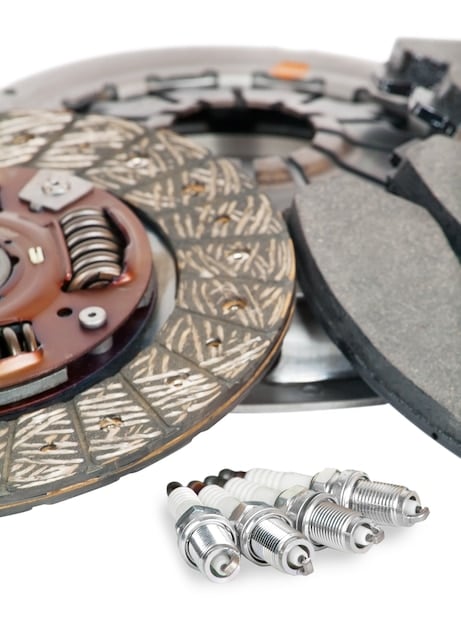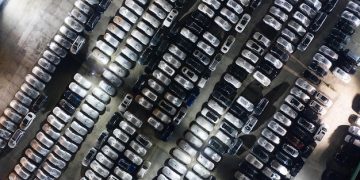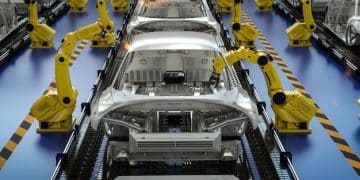Analyzing the Impact of Auto Part Tariffs on US Car Manufacturers

The 10% tariff increase on imported auto parts significantly impacts US car manufacturers by raising production costs, potentially leading to higher vehicle prices for consumers and affecting the competitiveness of the US auto industry.
The automotive industry is a complex web of global supply chains, and changes in trade policy can have significant ripple effects. A recent 10% tariff increase on **imported auto parts on US car manufacturers** has sent shockwaves through the industry. Understanding the impact of this tariff is crucial for automakers, consumers, and policymakers alike.
Understanding the Auto Parts Tariff
Tariffs, in general, are taxes imposed on goods imported into a country. In this case, the US government has implemented a 10% tariff on specific auto parts brought into the country from abroad. This measure is intended to protect domestic industries and incentivize local production, but its effects are far-reaching.
The Rationale Behind the Tariff
The stated goals of the tariff include boosting the US auto parts manufacturing sector, creating jobs, and reducing reliance on foreign suppliers. Proponents argue that tariffs will encourage companies to invest in US-based facilities and hire American workers.
Which parts are affected?
The tariff doesn’t impact every single auto part. Generally, the tariff impacts components, such as:
* Engine components such as pistons, camshafts and crankshafts are imported.
* Transmission elements like gears, shafts, and complete transmission systems are impacted.
* Electronic components like sensors, control units, and wiring harnesses.
* Also, chassis parts, suspension parts, and brake parts are taxed during import to the US.
The tariff on auto parts can change the costs for american car manufacturers. However, there is a need to consider how it changes the whole automotive industry.

Increased Production Costs for US Automakers
The most immediate impact of the tariff is the rise in production costs for US car manufacturers. Many automakers rely on a global network of suppliers to source components at competitive prices. A 10% tariff adds a direct cost to imported parts, squeezing profit margins and increasing the overall expense of building vehicles.
For instance, a car that requires $10,000 worth of imported parts will now cost an additional $1,000 to produce. These increased costs often get passed on to consumers in the form of higher vehicle prices.
Impact on Profit Margins
Automakers operate on relatively thin profit margins, and a sudden tariff increase can significantly erode their profitability. They may have to absorb some of the cost increase, reduce investments in research and development, or find ways to cut costs elsewhere in their operations.
The Supply Chain Disruption
Changing the supply chain is not done overnight. Therefore the US auto manufacturers face a hurdle:
* It requires scouting for new suppliers. It requires negotiating costs and contracts.
* It also involves logistical planning and quality control checks.
* It may lead to delays, production bottlenecks, and increased complexity.
While the tariff may aim to shift production to the US, manufacturers need to adapt over the short term.
Potential Price Hikes for Consumers
As production costs rise for US automakers, there’s a strong likelihood that these costs will be passed on to consumers in the form of higher vehicle prices. This can make new cars less affordable and impact consumer demand.

Affordability Concerns
For many Americans, buying a new car is a significant financial decision. Even a small price increase can deter potential buyers, particularly those on a tight budget. The tariff could disproportionately affect lower-income individuals and families.
Impact on Sales Volumes
Higher prices often lead to lower sales volumes. As vehicles become more expensive, consumers may postpone purchases, opt for used cars, or choose vehicles from brands not subject to the tariff. This can have a cascading effect on the entire auto industry.
How Automakers Might Respond
Responses from car manufacturers differ from business to business. Some of them are:
* Reduction in features to remain competitive on pricing
* Introduction of cheaper trims of certain car models
* Promotions for the old stocks
These initiatives can change the market dynamics; however, some companies may choose to accept lower margins.
Competitiveness of the US Auto Industry
The tariff can affect the competitiveness of the US auto industry in the global market. Higher production costs can make it more difficult for US-made vehicles to compete with those produced in countries without such tariffs.
Impact on Exports
If US-made cars become more expensive to produce, it can be harder to export them to other countries. This can harm the trade balance and reduce the industry’s contribution to the US economy.
Attracting Foreign Investment
The tariff can make the US less attractive for foreign automakers looking to establish production facilities. Companies may choose to invest in countries with lower production costs and more favorable trade policies.
Innovation and Growth
The reduction in growth and sales can affect the potential to innovate. Consider these aspects:
* Reduced R&D because of reduced budgets.
* Delay in the roll out of new features because of increased cost of compliance.
* Less investment in the employees which in turn affects the ability of the businesses to grow.
Innovation is the keystone of the market dynamics and can directly impact sales.
Potential Benefits of the Tariff
While the tariff has several potential drawbacks, there are potential benefits to consider. These include boosting the domestic auto parts industry, encouraging local production, and reducing reliance on foreign suppliers.
Boosting Domestic Production
The tariff could incentivize automakers to source more parts from US-based suppliers. This can lead to increased demand for domestic auto parts and create jobs in the manufacturing sector.
Reducing Reliance on Foreign Suppliers
By making imported parts more expensive, the tariff could encourage automakers to diversify their supply chains and reduce their dependence on foreign sources. This can make the industry more resilient to global disruptions.
Job Creation
If domestic auto parts manufacturers increase production, it could lead to job creation in the US. This can have a positive impact on the economy and local communities.
Alternative Strategies for Supporting the US Auto Industry
While tariffs are one way to support the US auto industry, there are alternative strategies that could be more effective and less disruptive. These include investing in research and development, improving infrastructure, and streamlining regulations.
Investing in Research and Development
Government support for research and development in the auto industry can foster innovation and help US companies develop cutting-edge technologies. This can make US-made vehicles more competitive in the global market.
Improving Infrastructure
Investing in infrastructure, such as roads, bridges, and charging stations for electric vehicles, can make the US more attractive for automakers and consumers alike. This can help boost demand for US-made vehicles.
Streamlining Regulations
Reducing red tape and streamlining regulations can lower the cost of doing business in the US and make the country more attractive for automakers. This can help attract foreign investment and create jobs.
| Key Aspect | Brief Description |
|---|---|
| 💰Cost Increase | Tariff increases production costs for US automakers relying on imported parts. |
| 📈Price Hikes | Consumers may face increased vehicle prices due to higher production costs. |
| 🏭Domestic Boost | It could potentially boost domestic auto parts production and create jobs. |
| 🌍Competitiveness | The tariff could challenge the competitiveness of US automakers globally. |
FAQ
▼
The tariff generally affects a wide array of components, including engine, transmission, electronic, chassis, suspension, and brake parts imported into the US from various countries.
▼
Due to increased production costs for US automakers, there is a notable possibility that these expenses will be transferred to consumers, resulting in higher prices for vehicles.
▼
Yes, an increased demand might mean to boost domestic auto parts production. It in turn implies job creation in certain sector of the US manufacturing.
▼
Tariffs can make it more challenging for US-made vehicles to compete globally. Higher production costs could influence exports and reduce foreign investments too.
▼
Yes, supporting research, developing infrastructure, and simplifying the processes might be an alternative. These could potentially make the US more appealing automarket.
Conclusion
The 10% tariff increase on imported auto parts presents a complex challenge for the US auto industry. While it aims to boost domestic production and create jobs, it also carries the risk of increasing production costs, raising vehicle prices for consumers, and impacting the competitiveness of US-made vehicles in the global market. It is imperative on the manufacturers to take calculated steps.





